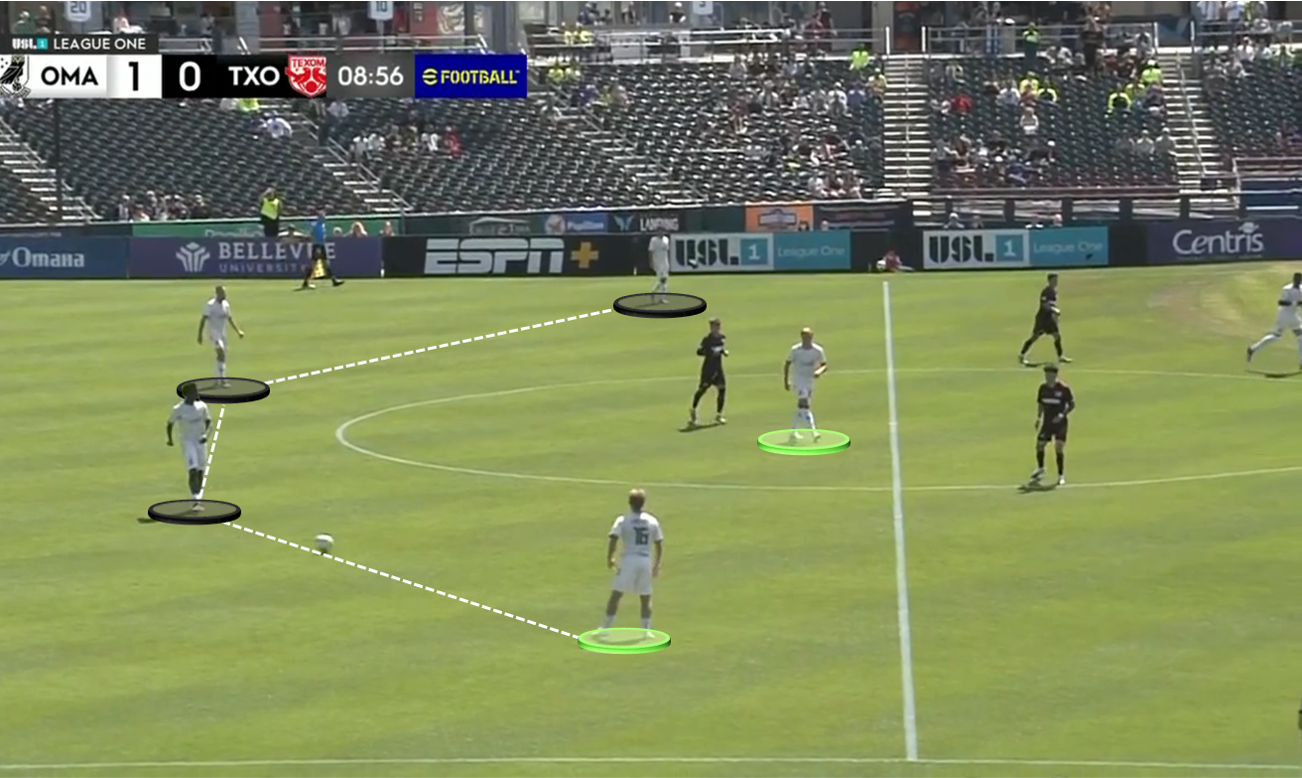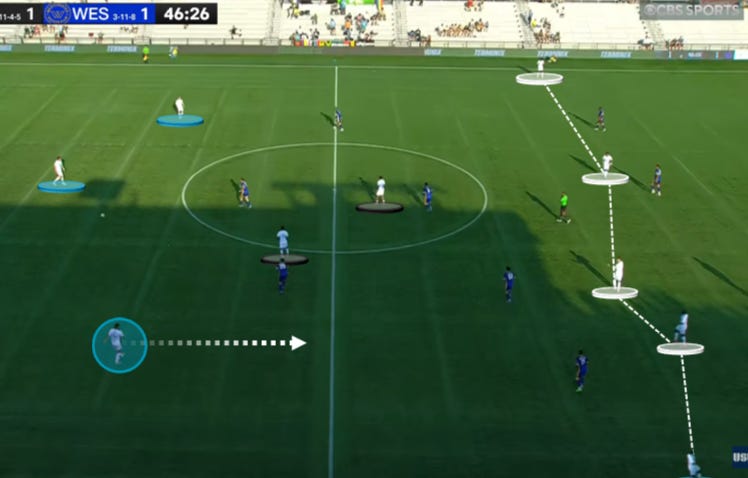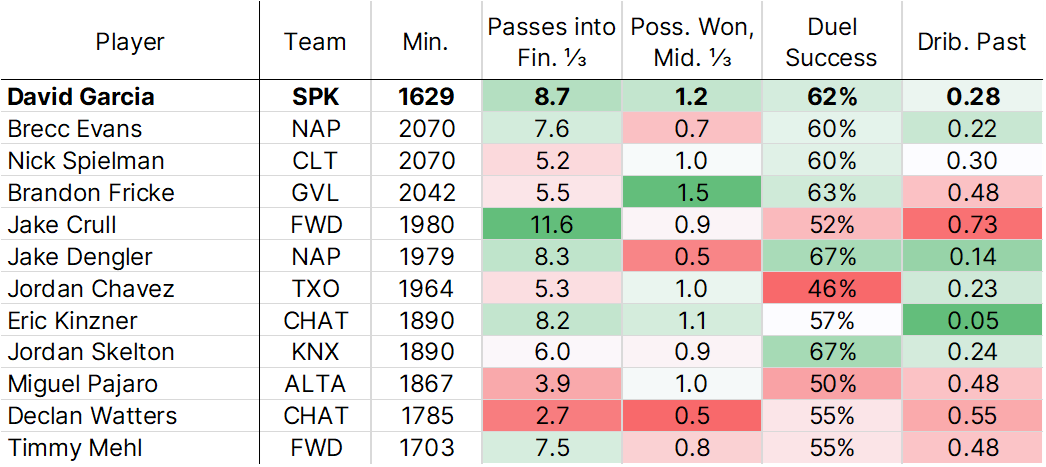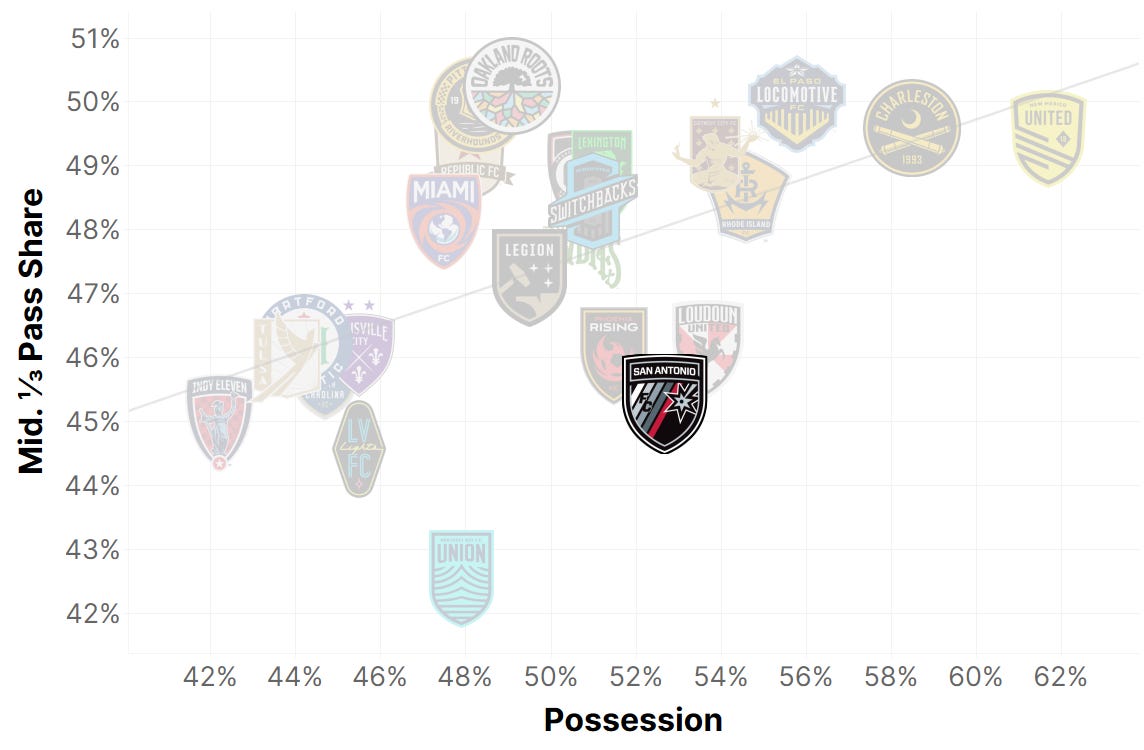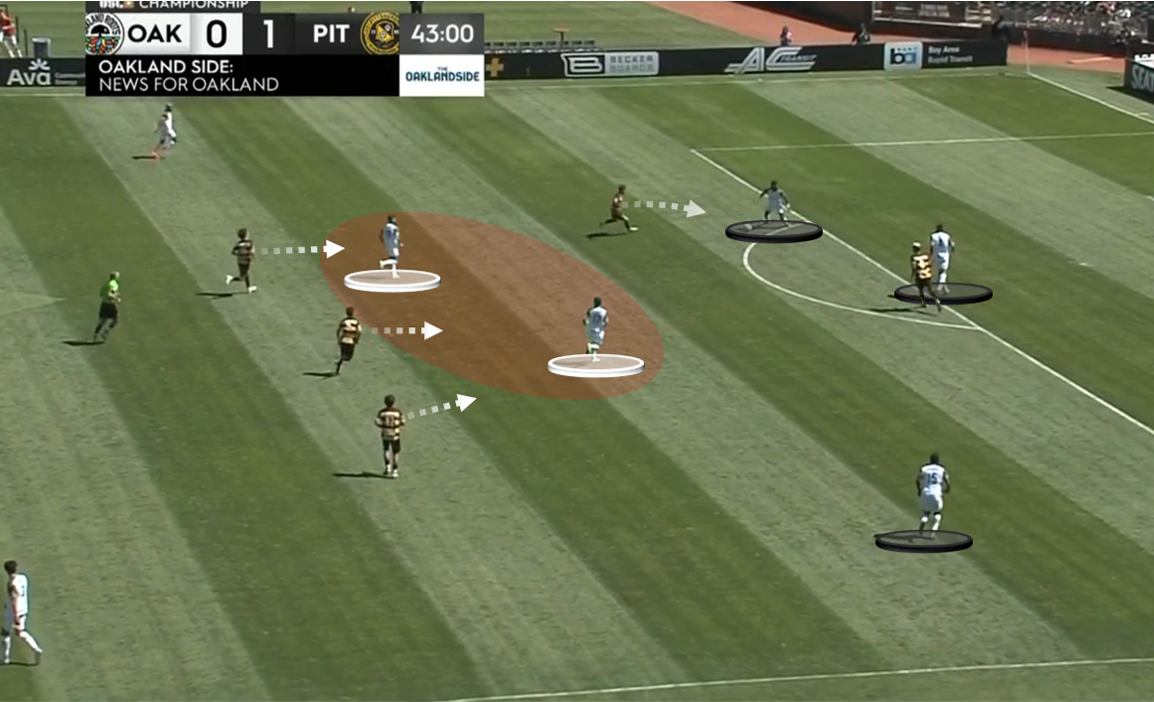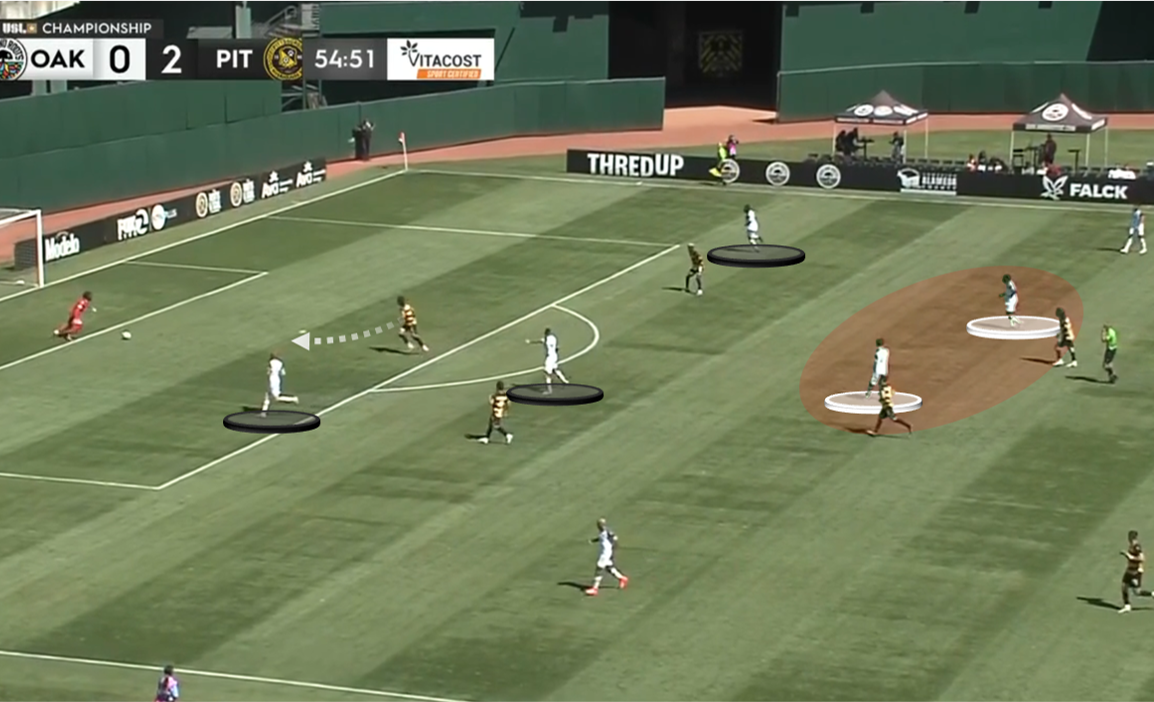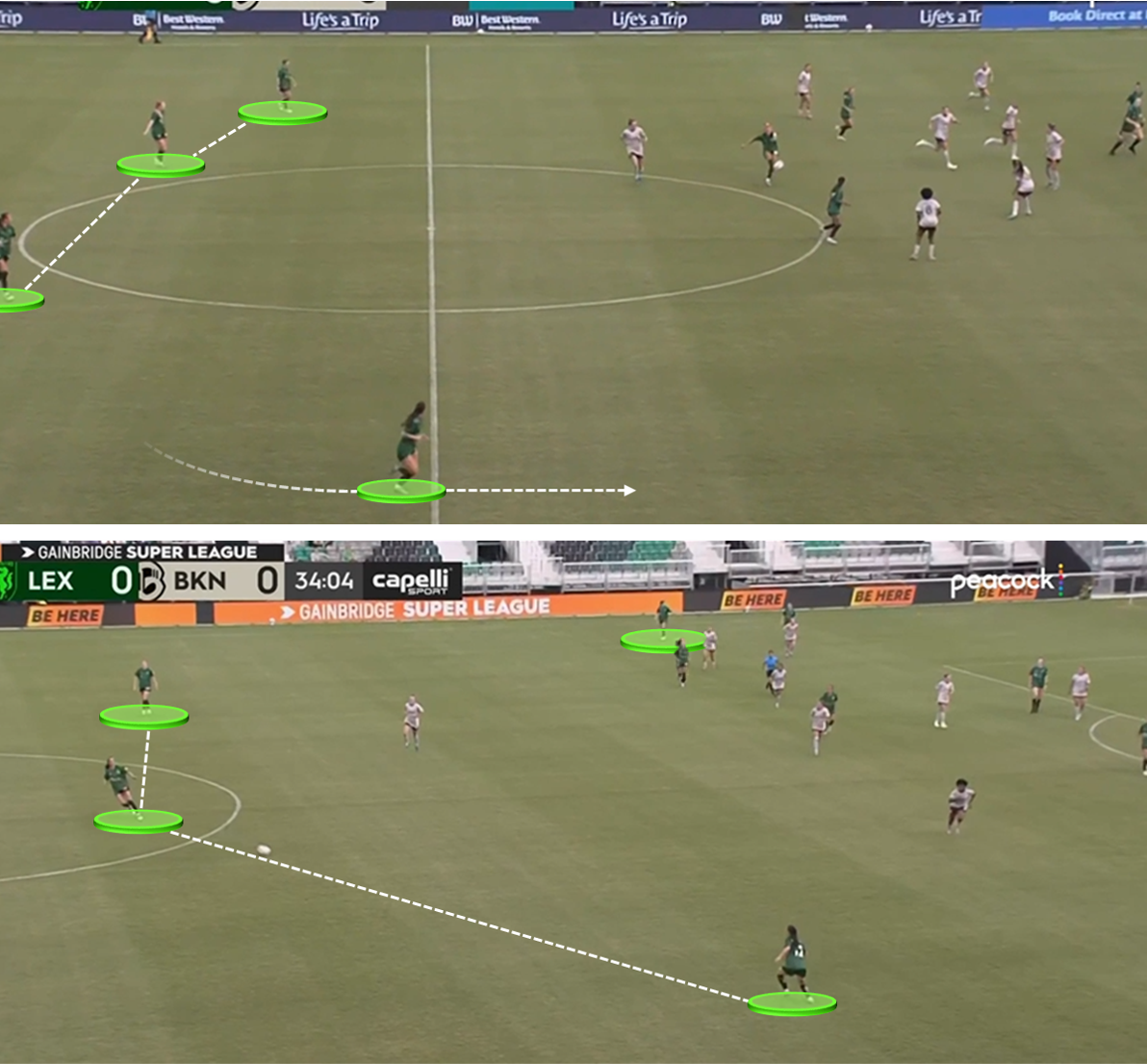The Back Four: Owls, Wolves, and Western woes
On San Antonio, Oakland, League One's elite, and more USL miscellany
Welcome in to The Back Four!
As always, check out Backheeled for more USL content, including this week’s Jagermeister Cup review. You can also find This League! for an audiovisual dive into the week that was.
Without further ado, let’s get to it.
Omaha’s midfield manipulation
As Union Omaha continues to roll toward a playoff spot, it’s hard to ignore just how dominant their midfield has been. Max Schneider and Laurence Wootton have been good all season, but they’re playing with an assurance and cleverness under Vincenzo Candela that’s undeniable.
Together, the duo is perfectly complementary. Schneider has quietly been the best midfielder in the league by my statistical modeling, good for 90th percentile returns (or better!) for duel wins, touches, xA, and xG. Wootton comes up big in support of that box-to-box dominance, supplying defensive efficiency (84th duel win rate) and clean conduct on the ball (67% dribble success, 78% pass completion).
All of those features were on show in a rout against Texoma last weekend. Omaha rolled to a 5-0 victory, and the way they manipulated their 4-2-3-1 base shape around that pivot was sublime. Many a side has fallen against Texoma’s counterattack, but Wootton and Schneider provided a surety that all but sealed the match within 15 minutes.
How did the shape work? You’re seeing an example below, with left back Charlie Ostrem (in black) sitting somewhat deep. Meanwhile, right back Brandon Knapp is allowed to push up the sideline. Lots of teams lean into that sort of imbalance by design, but Omaha isn’t shifting into a back three. Instead…
…Wootton (in Omaha’s neon green-ish color) slides into Knapp’s place, while Schneider stays central and presents a passing option with numerous available angles. Omaha retains numbers to build forward, baiting Texoma to overextend.
Against a team known to defend in 4-1-4-1 with multiple high pressers, Omaha’s “four plus one” setup (a four-man defensive line and the holding No. 6) gave Los Búhos constant comfort. That sense cut both ways. Omaha completed 74 passes in the final third, but they also had ample numbers in rest defense. If the ball turned over, you could reliably expect both center backs and one of Wootton or Schneider to be in position to snuff out a counter.
Additionally, Knapp’s freedom – a byproduct of the midfield alignment – led to fruitful interchange with winger Mark Bronnik. The former Barca Residency Academy product has stepped into a starring role this year, and his heady movement in the channel alongside Knapp gave Texoma fits. Bronnik almost took up a shadow No. 10 role in the wonky 4-1-2-3 attack.
That alignment was evident on Omaha’s second goal, one finished by none other than the 18-year-old winger.
Again, you’re starting with Wootton as a fill-in fullback with Ostrem also deep. Texoma has to keep their wingers high, so Ostrem can find an edge that puts Ryen Jiba into a one-on-one against the rival right back.
When he receives, Jiba – the left winger – has ample options. Bronnik and Chelo Martinez sit in No. 10ish positions to receive on the cutback; Pato Botello Faz goes hard toward the center of the box. Even Knapp is available at the far post if the cross is overcooked.
Texoma can’t help but collapse toward their own net, so when Jiba’s cross caroms out of the 18-yard area, they don’t have anyone in position to claim the ball. Enter Schneider. In one fell swoop, the midfielder recovers possession, slots in Bronnik, and gives Omaha an intractable lead.
Between that dish and his wonderful headed goal minutes into the game, Schneider had a Saturday to remember on the scoresheet. Still, he and Wootton made their presence felt with and without the ball thanks to Candela’s foolproof system.
This club has been an xG juggernaut all year, but now the results are starting to match the data profile. I’d bet the farm that Omaha makes the playoffs and makes noise in the process, and the brilliance of Max Schneider and Laurence Wootton up the middle is a major reason why.
On David Garcia
When the Spokane Velocity put their foot down, there isn’t a more controlling team in USL League One.
Need an example? Coming out of halftime over the weekend, the Velocity were tied 1-1 against visiting Westchester. For the next 14 minutes, Spokane put their foot on the ball, flexing into their 3-2-5 attacking shape and going to work. Westchester attempted just seven passes in the next 14 minutes – at which point Jalen Crisler scored to give Spokane their game-winner.
You could point to a million factors that allow Spokane to look so dominant, but David Garcia’s influence is hard to understate. The center back won the league with North Carolina in 2023, took home the Jagermeister Cup with Northern Colorado last year, and might earn a third-straight trophy in 2025.
Garcia defends as the right-sided center back in the Velocity’s off-ball 4-4-2, flowing into a more expressive role when his side regains. You’re seeing that above: Spokane flexes into the 3-2-5 by dropping Derek Waldeck low at left back, turning Lucky Opara into a winger, and thus making Garcia an outside defender on his stronger right foot.
The numerical advantage wrought by that shape is obvious – think about all the three- and four-man combinations up the channels! – but only if you’ve got a sufficiently talented passer at the base. In 2025, Garcia has advanced play by 11.4 yards per pass, a top-ten mark among starting center backs. He’s exceeded his expected completion percentage, and he’s only lost possession on 15% of his touches – lower than comparable center backs like Brecc Evans or Preston Kilwien.
Against Westchester, Garcia completed 10 passes into the pivot. The Spaniard also hit 10 into Opara, seven of which represented attacking-half entries. The result? Overloads like above, where Opara receives against a backtracking defense.
Here, he’s able to combine with an underlapping runner, dribble inside, or cross on his own right foot. Opara created four chances over the weekend, and he’s taking 2.5 box touches per match across 2025. Patterns like this were an engine for Spokane all throughout Sunday night – just like they’ve been all year.
All of the freedom upfield is enabled by Garcia’s steady defending at the back. Spokane has allowed a league-low 18 goals to date, in line with an xG against of 17.9. Meanwhile, the Velocity have allowed just 13 fast break shots all season. That’s 35% below the League One average, and it’s a testament to a Garcia-led ability to transition from the 3-2-5 into a low-block 4-4-2.
As a whole, Spokane is one of the more aggressive teams in the league. They’ve put in 15.4 tackle attempts per match, second only behind Greenville. By contrast, Garcia has only tried 0.93 tackles per match – of which he’s won a sterling 78%. It’s that ability to read the situation, stabilize the shape, and pick prime moments to intervene that’s so definitional to Garcia’s game.
Among the dozen most-used center backs in League One, the Spaniard is exemplary in the categories that Spokane values the most. He’s the second-leading passer at his spot in terms of final-third entries, and he’s also second in upfield recoveries. If you need someone to hit a pass into the attacking zone and support offensive-titled possession, Garcia is your man.
When he’s staying at home, the center back is equally good. Garcia is winning a stellar 62% of his duels. He’s only been dribbled past five times all season, an especially strong count relative to other wide-ranging defenders with passing responsibilities.
When Garcia signed for Leigh Veidman this offseason, the prevailing sense was that he’d be a difference-maker. Garcia has gone far and above that expectation; as of now, he ought to be the Defender of the Year. Spokane is a great team for a whole lot of reasons, but David Garcia’s excellence might be chief amongst them.
San Antonio, fading?
San Antonio FC isn’t interested in patiently working through the midfield. This team hasn’t won a game since mid-July, but that commitment to high-tempo progression into the final third might has remained a constant. Is the system sustainable? Can it get San Antonio to the playoffs? The answers might be “no,” but it’s worth digging into Carlos Llamosa’s tactics to find out.
In some sense, it’s odd that the team with Jorge Hernandez doesn’t use a more conventional, No. 10-driven style. Year-over-year, San Antonio’s possession average is up almost 5%. This is a top-ten ball control team in the Championship. At the same time, Hernandez’s touches are down 12%.
Alen Marcina’s system was direct and vertical, but the ball always routed to Hernandez’s feet after a regain. Under Llamosa, SAFC is likelier to skirt the midfield entirely – there’s a bifurcation between patient set-up play at the back and a go-for-broke final-third offense.
You’d naturally expect a high-possession team to play a larger share of their passes through the midfield, and the data bears out a loose link between those numbers. San Antonio is something of an outlier; only Monterey is less focused on middle-third passing relative to their total possession share.
Why is that happening? SAFC bases their formation out of a 4-2-4, tilting one of their fullbacks forward into a 3-2-5 as they enter the final third. Build starts short; San Antonio is happy to knock the ball around at the back and goad the opposing defense forward, hoping to create gaps upfield. Goalkeepers Daniel Namani and Richard Sanchez rank 23rd and 33rd at their position for vertical passing distance because they start short so often.
I’m not here to deny the logic of the system. However, San Antonio’s offense has a ramshackle, high-risk energy that isn’t conducive to consistent results.
Take the play here from last weekend’s loss against New Mexico. The ideas are strong. SAFC waits for the defense to bite, then they spot an overload up their right and pick out striker Juan Agudelo.
Agudelo links with Nick Hernandez, the second striker, who quickly tries an overly ambitious ball toward Jorge Hernandez on the left. For me, the ensuing incompletion captures a lot of the issue for San Antonio.
This team knows how to speed the game up, but they don’t have an ability to slow things down. If Hernandez takes a beat, he’d be able to dribble forward, allow teammates to advance, and set up a field-tilting sequence close to goal. Instead, there’s a “go-go-go” attitude that leads to sloppiness.
Since the start of July, San Antonio has posted the USL’s third-least xG in the run of play, just 0.65 per match. There’ve been bright moments with Harvey Neville and Nelson Blanco Flores overlapping from the fullback spots; Jorge Hernandez continues to read space at an elite level. Still, the star talent and considerate shape haven’t amounted to genuine results.
The intense verticality has also created post-turnover trade-offs. There’s an inherent risk to the shape changes, and Llamosa has emphasized clean transitions back into the 4-2-4 from the 3-2-5. As such, San Antonio is only giving up 0.07 break xG per match over the last two months.
At the same time, the focus on recoveries have kneecapped the counterpress. SAFC has recovered the ball in the final third just 2.4 times per match in that aforementioned time span, the second-lowest number in the Championship. Thus, you’ve got a team that’s (1) good at entering the final third but (2) too sloppy around the box and (3) ineffective at retaining the zone via counterpressure.
It’s a nasty mix, and while injuries haven’t helped the cause, you’d like to see San Antonio moderate. Find Jorge Hernandez at his feet more often! Let Lucio Berron be more expressive as a mid- and short-range passer when he’s fit! The talent is there, but the system is too extreme. Unless a change arrives, there’s a real chance San Antonio misses the postseason.
Uprooted
Here’s a member of Oakland’s defensive unit being closed down at an arced angle, limiting access to the sideline. Meanwhile, the pivot within the Roots’ 3-4-3 can feel the heat of multiple back-side pressers:
Once more, here’s a member of Oakland’s defensive unit being closed down at an arcing angle, limiting access to the sideline. Meanwhile, the pivot within the Roots’ 3-4-3 can feel the heat of multiple back-side pressers:
The first sequence sees center back Kai Greene caught with the ball under his feet. He’ll turn the ball over and help the Roots to cede a penalty moments later. Meanwhile, the second play will end with goalkeeper Kendall McIntosh knocking the ball out of bounds at the left sideline.
In each case, the Roots are too predictable. I’m sympathetic to the fact that Oakland lacked their best ball-seeking circulator at the No. 6 spot in Tyler Gibson this weekend. Likewise, Peter Wilson’s absence denied Benny Feilhaber any hold-up presence at the No. 9 spot, limiting pressure-relieving long balls.
Feilhaber is working with a squad that isn’t built for his style of play, but he isn’t meeting the roster halfway. This club is fiercely committed to short, safe passing. Their expected completion percentage (81%) is sixth-highest in the USL since Feilhaber took charge, and their average progressive distance per pass (5.7 yards) is fourth-shortest in the league.
The Roots’ 3-4-3 system is intended to work in a “three-box-three” mode. You’re climbing the ladder from a line of three central defenders into a “box” composed of a double pivot and two No. 10s. Fullbacks like Morey Doner and Julian Bravo are meant to push high around the edges of the overloading middle group.
I’ve got a lot of love for players like Greene and Gagi Margvelashvili, but they aren’t exactly technicians in central defense. Beyond the lack of incision at the back, Oakland doesn’t have creators at the No. 10 spots – or refuses to use the proper players in those positions. On Sunday, Panos Armenakas and Faysal Bettache (this club’s only natural No. 10s!) paired together in the pivot, whilst Daniel Gomez and Jurgen Damm sat further ahead.
I don’t get it? Damm is technical enough to sorta do the job, but it felt like a “square peg/round hole” alignment nonetheless. Bettache and Armenakas, meanwhile, lacked defensive heft and weren’t given enough opportunities to be expressive. Bettache came off at halftime, at which point he hadn’t attempted a single duel or tackle; Armenakas went 72 minutes and went zero-for-four on duels…but at least the aggression was there? Neither player created a chance.
Writ large, I truly like the direction Oakland is heading. Feilhaber’s system is fun to watch when it’s working! That said, it isn’t working often enough, and there doesn’t seem to be a viable “Plan B” in terms of tactics and personnel alike.
As it stands, the Roots are six points back of the pace without games in hand. Since Feilhaber took charge, this club is minus-1.7 in xG terms and has generated less shots per game than any other USL team. Even if the ideas are inspired, Feilhaber and his Roots feel like they’re leaving points on the table. Balancing “win-now” needs against broader principles is never easy, but my sense is that the Roots aren’t getting that balance right.
Chattanooga’s unsung attack
Chattanooga and Spokane are in a dead heat in the race for USL League One’s best defensive record, at least as far as the headline stats go. The Red Wolves have allowed just 1.07 xG per match to pip the Velocity by a margin of one one-hundredth; Chattanooga, meanwhile, is the only club holding opponents under 10 shots per match.
At the same time, that success is obfuscated by some of the Red Wolves’ underlying numbers. Chattanooga has allowed the fifth-most passes per match (96.6) in their defensive third. They’re ninth in League One with just 6.6 interceptions per match, wildly low for a team that only possesses the ball 36% of the time.
What explains those data points? No team is more comfortable absorbing pressure. Scott Mackenzie has a formula: his 5-4-1 is designed to break out quickly, earn early leads, and then defend to see those leads out.
Since they last lost a match on June 28th in the Jagermeister Cup, Chattanooga has trailed for nine minutes out of a possible 1,080. Meanwhile, they’ve led for 480 of those minutes and scored the winning goal in the first half on four separate occasions. It took until the 90th minute for the Red Wolves to get over the hump against Charlotte last weekend, but Mackenzie’s usual principles stood out.
Chattanooga is stellar about overloading the channels. While chasing the lead, they often play longer passes toward the sideline that either (1) put a runner behind the defense, (2) set up a dangerous throw or set piece, (3) or allow for a second-ball situation. You get a taste for that recipe here, where a long pass up the left side toward winger Pedro Hernandez is headed clear and recovered by Jordan Ayimbila, the left wingback in the 3-4-3.
As soon as Ayimbila regains, he’s looking upfield. The Red Wolves are constantly looking to push forward when they get into these spaces, and that manifests by way of a Ayimbila-Hernandez give-and-go in this case.
Meanwhile, striker Greyson Mercer understands how he can contribute. Initially, Mercer takes an inside position against opposing Charlotte’s centermost defender. Doing so prevents that player from intervening as Ayimbila receives on the return pass.
Once Ayimbila is clean through, Mercer breaks. He knows he’ll be needed closer to the net, so the No. 9 curls inside as a potential receiver on the cross. Between the moment where the wingback recovers possession and the ultimate clearance by the Independence, just nine seconds have elapsed.
What we tend to underrate is Chattanooga’s ability to look classy with the ball. This team is direct, but they can string passes together when the matchup demands it.
Take the Independence game once more. Mackenzie’s side couldn’t just sit back with the match tied, and they ultimately held 46% of possession. In the process, they outshot the guests 14 to six, posting a 9% higher completion rate in the final third than the Independence.
Chattanooga trains you to expect the long ball, but they can punish a defense if given time. Above, you’re seeing a familiar start to an offensive sequence, but instead of going long, Chattanooga engages right wingback Yanis Lelin on the drop. You get another give-and-go, but this time Lelin and midfielder Ualefi are the participants.
The result? Lelin is activated in space, forming a passing triangle with Mercer and winger Omar Hernandez. Those two forward runners wisely make crossing cuts, opening up Hernandez in zone 14. There, he nearly threads a teammate in on goal.
28% of all Chattanooga pass completions this year have come in the final third, the highest share in League One. That’s because of their verticality, yes, but it also owes to the patterns that Scott Mackenzie has created all over the pitch. It’s easy to think that an elite defensive team is solely focused on defending, but the Red Wolves’ model is holistic to an extent that doesn’t get enough love.
Quick Hits
In other news this week…
The wonderful folks at Morning Kickaround are live from New Mexico this weekend, and you should tune in.
More Super League coverage coming soon! For now, I’ll leave you with this:
Lexington’s 4-4-2 press is terrific, and Sarah Griffith might be the best new player in the league, but I’m particularly enamored with this club’s dynamic at fullback.
Up top, You’re seeing Alyssa Bourgeois push up from right back while left back Hannah Johnson sits in. The opposite is true in the second frame, where Bourgeois’ depth will stretch the defense and set up a right-sided goalscoring move.
If you read the rest of the newsletter, you’ll detect notes of Spokane. It’s great stuff from Masaki Hemmi, and it’s why this team already has a +1.0 xG margin through two games.
After starting 17 league games last year, Justin Malou had become an end-of-bench piece for North Carolina. Comfortable as a center back or right back, he’s a stellar addition to the Tormenta back line. Don’t look now, but South Georgia is getting their stride at the perfect moment.
Zane Bubb was so, so, so good for Greenville even in a losing effort in their Jagermeister Cup semifinal against Hartford. The numbers were excellent (see five clearances, three interceptions, and a 75% duel win rate) but his ability to tighten the screws on Michee Ngalina didn’t show up on the stat sheet. Great player, and he’ll be key down the stretch.
Light media consumption week for me – the newsletter moved days for a reason! – but I simply cannot wait for One Battle After Another. I live a two-minute walk from one of three theaters on the planet that’s showing it in its original VistaVision format.

